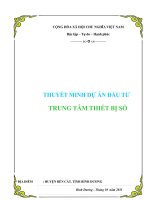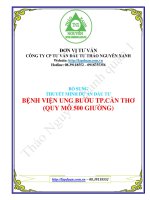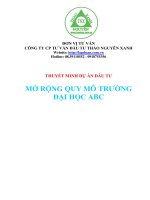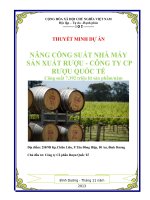Thuyết minh dự án dưa lưới
Bạn đang xem bản rút gọn của tài liệu. Xem và tải ngay bản đầy đủ của tài liệu tại đây (2.17 MB, 29 trang )
Melon
presented by Kuji
CONTENT
1
Introduction
2
Production Activities
3
Kuji’s Solution
4
Conclusion
INTRODUCTION
BIOLOGICAL PROPERTIES
• Melon is a species in the family Cucurbitaceae.
They have relatively short growth period and can be
grown all year round
• They originate from India and Africa.
• Their weight is from 0,5 kg to 5 kg.
• They are suitable with wet and well-drained soil and
hot climate as Vietnam.
• They are sensitive to the impact of external factors
such as nutrition, water and pests.
CULTIVATE CONDITION
. Temperature
. Soil
For burgeoning: from 21°C to 32°C
Light soil, sandy soil (high
For growing: from 16°C to 35°C
soil base, well-drained),
.
Climate
pH level from 6.0 to 6.5
Hot
. Planting density:
Planting density and planting distance is in single rows in dry
season, reaching number of 2500-2700 trees/1,000m 2 ; and
in rainy season.
2200-2500
trees/1000m
2
NUTRITION FACTS
Nutrition Facts per 100g
(3.5 oz)
Energy
Carbonhydrate
Protein
Fat
Cholesterol
Fibre
Folate
Niacin
Axit Pantothenic
Pyridoxine
Riboflavin
Thiamin
Vitamin A
Vitamin C
Vitamin E
Vitamin K
Sodium
Potassium
Calcium
Copper
Iron
Magnesium
Manganese
Zinc
34Kcal
8,6g
0,84g
0,19g
0 mg
0,9g
21µg (5%)
0,734mg (4,5%)
0,105mg (2%)
0,072mg (5,5%)
0,026mg (2%)
0,017mg (1%)
3382IU (112%)
36,7mg (61%)
0,05mg (0,5%)
2,5mcg (2%)
1mg (0%)
267mg (6%)
9mg (1%)
41µg (4,5%
0,21mg (2.5%)
12 mg (3%)
0,041mg (2%)
0,18mg (1.5%)
Melons have high nutritional value. They are
the source of antioxidant in polyphenol form
and health benefits in strengthen the immune
system and prevention of cancer. These
substances regulate the formation of nitric
oxide which is important for endothelium and
cardiovascular system.
Melon is good for variety of diseases:
• Acne, allergies, anemia
• Headache, diabetes, impotence
• Diseases
of
the
blood
pressure,
metabolism, bowel, prostate.
• Hemorrhoids, stress, rickets, sinusitis.
• Thyroid problems, etc.
CULTIVATION
• Melon is very sensitive to weather, so water for irrigation
should be clean water resource, pH level from 6 to 7, no
salt and no alum.
•
Fertilizers such as KNO3, MgSO4, K2SO4, (NH4) 2SO4,
urea, KH2PO4, Ca (NO3) 2 are often mixed in water as
nutritional liquid ensuring full elements necessary for melon
to grow and develop such as K, N, P, S, Ca, Mg, etc.
• Nutritional liquid and water irrigation are supplied
simultaneously through Drip irrigation system and has a
suitable concentration for the nutritional needs at each
stage of plant growth.
HARVEST
Melon should be harvested at the right time based on ripe
indicators (based on factors such as the time, level of skin
generation and stem cracking) to get the best quality and
prolong storage.
Time of stem cracking – 58 days
Time of stem breaking – 65 days
PRODUCTION ACTIVITIES
IN GLOBAL
• Melon is grown and produced in most
of the tropics and subtropics,
including the Mediterranean and
• Southern Europe.
Mexico is the world's largest melon
producer but mostly for domestic
consumption and export to the North
American market; followed by India,
Brazil and the Central American
countries.
Figure 1: Top melon producers in the
world (million tonnes)
IN GLOBAL
Figure 2: Top melon importers in the
world (million tonnes)
Figure 3: Top melon exporters in the
world (million tonnes)
IN VIETNAM
•
•
•
Melon has been introduced into Vietnam for 4-5 years. Annual revenue was from 3 to 4
VND billion/ha and profit was from 25% to 30%.
Melon is a luxury item, has been consumed mainly in supermarkets, restaurants and
hotels.
Currently, Vietnamese consumers become more and more preferring melons.
Therefore, though increasing in farming area, supply still does not satisfy demand.
• At first, in order to reduce costs, many farmers
planted melons in the field like watermelons; but
it was easy to be influenced by pests and
diseases, unstable quality and yield led to
ineffective production. Currently, melons are
planted in greenhouse made by Israel
technology, which has been considered
effective economic in Lam Dong, Tay Ninh, Ben
Tre, Dong Nai, Ho Chi Minh City, etc. Melons
grown in greenhouse can be planted for 4 crops
and yields of 20-40 tonnes/ha.
IN VIETNAM
• Melon seeds sold are imported
from Thailand, Taiwan, Japan, etc.
Their price are from 1.000 to 8.000
VND per seed, high quality seeds
price are from 1 to 2 USD per
seed. Good quality seeds are
usually rare and expensive.
• Some imported varieties of melon not adapted to the ecological
conditions have been badly fruited. Meanwhile, high cost of melon
cultivation has led to susceptible to get loss.
•
Recently, Chinese melons are sold widely with cheap price in Vietnam
market, but that is not enough to make Vietnamese melon price
decrease due to difference of melon quality.
OPPORTUNITY FOR VIETNAM
Currently, Japan is a potential market of Vietnamese melons:
• Domestic retail price of melon is always from 35.000 to 60.000
VND/kg, while export price to Japan is from 75.000 to 85.000
VND/kg.
• In Japan, melons are planted only for 2 crops per year (harvest from
April to September), while Vietnam has 5 melon crops per year.
• Vietnam has a great opportunity of export expansion by joining TPP
together with Japan, Singapore and Korea. Meanwhile, Japan’s
government is laying down as a policy importing agricultural products
from Vietnam under Japanese standards.
RECOMMENDATION
FOR VIETNAM
Some recommendations to strongly exploit
melons export potential to Japan:
Vietnamese
• Investing in research, applying strictly cultivation methods under
Japanese standards in order to enhance quality of products and
stabilize output to meet the demand for export markets.
•
Applying high technology greenhouse system to improve
product quality, branding and reduce production costs for
corporations.
•
Understanding and meeting strict quarantine standards of
Japan to expand export opportunities.
KUJI’S SOLUTION
KUJI’S SOLUTION
• Selecting the best varieties from Japan which are suitable for
Vietnamese pedology such as Taki, Taka and Tazoti.
• Investing package in infrastructure of greenhouse.
•
Applying of technical measures with high-tech application
such as Drip irrigation system which is automatically inject
fertilizer and proactively control pests.
• Facilitating the best conditions for plants growth, ensuring
productivity and stabilize quality of plants.
KUJI’S SOLUTION
Description of the control system via Smartphone
KUJI’S SOLUTION
Function of the control system via Smartphone
KUJI’S SOLUTION
Outstanding technical advantages of the Greenhouse installed by Kuji:
•
•
•
•
•
Providing the complete solution of Greenhouse for planting melon under
technique and standards of Japan.
Achieving high internal rate of return (IRR) (32.92% and 175.90%) and
ensuring high and stable price of output for long-term (through the
supermarket system such as Co-op Mart, Big C, Aeon, Family Mart and
partners in Japan, Korea and Singapore).
Using high technology, automatic controller and traceability for each plant
and each melon via Smartphone (Meteorological station, Control pH & EC
device, Temperature, humidity and light inside the greenhouse monitor).
Ensuring optimum and the best growing conditions for melon.
Saving fertilizer, water and labor; increasing productivity and stable quality
of melon under Japanese import standards.
COST ESTIMATION
No.
Categories
Investment in
greenhouse and
equipment system
Order
Quantity
1.000
Unit
m2
Unit price
(VND)
Amount
(VND)
509.250 509.250.000*
A COST PER CROP
Imported melon
seeds per crop
Planting bed per
2
crop
Nutrition and
3 Botany Protection
Medicine
1
4
Labour
5 Energy for system
operation
6
Infrastructure
depreciation
7
Other cost per crop
I
Total cost per
crop
Total cost per
year
*Provisional price
2.600
plant
2.350
2.600
each
5.175
1
crop
7.500.000
6.110.000
13.455.000
20.000.000
1
3.000.000
1 m2 per
crop
3.000.000
20.370
2.000.000
72.435.000
362.175.000
III
Amount
(VND)
3.510
kg
31.000
108.810.000
390
kg
20.000
7.800.000
1 crop
116.610.000
44.175.000
Domestic profit per year
220.875.000
Domestic NPV
361.139.319
Domestic IRR
32,92%
C EXPORT REVENUE
1 Plant A revenue
20.370.000
2.000.000
REVENUE
B DOMESTIC REVENUE
Plant A revenue (90%)
1
plants
2.340
Plant B revenue (10%) 260
2
cây
II Total domestic revenue per
crop
Domestic profit per crop
(II - I)
7.500.000
person
2
10.000.000
per crop
crop
No.
Unit
Order
Unit price
Quantity
(VND)
Total export revenue per
crop
Export profit per crop
(III - I)
Export profit per year
Export NPV
Export IRR
3.510 kg
72.000
252.720.000
252.720.000
180.285.000
901.425.000
3.042.943.286
175,90%
CONCLUSION
CONCLUSION
1. Melon is high-end item with high economic value and
can become short-term plant. Their large domestic and
export market bring high profit effective economy for
Vietnam’s agriculture.
2. Melon is contributing to the restructuring of the plant
oriented Vietnam’s government.
3. Melon should be cultivated in the high-tech greenhouse
system in order to reduce production costs, improve
product quality, bring added value and high economic
efficiency in order to meet domestic and exports
demand.
PHOTOS TAKEN IN
NONG PHAT FARM
Nhật Bản expert transferred technology.
PHOTOS TAKEN IN
NONG PHAT FARM
Dutch expert shared experiences.
Israel expert shared experiences.









